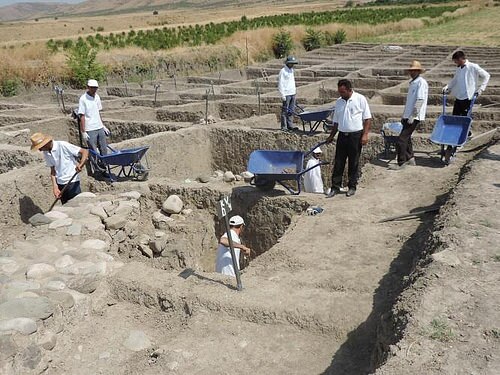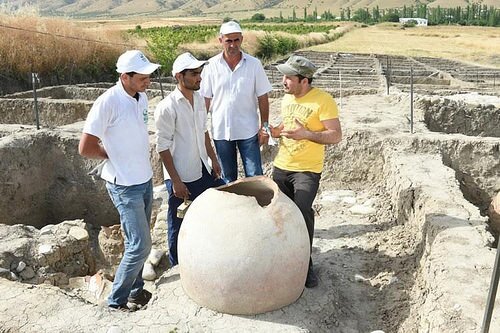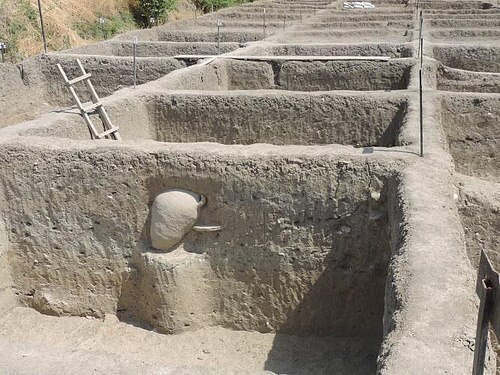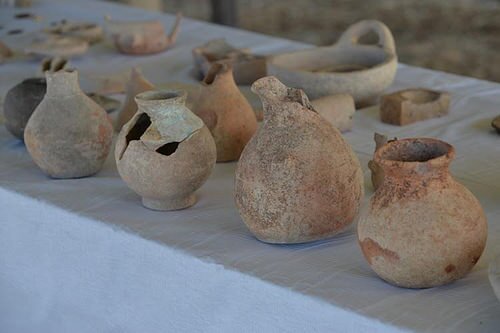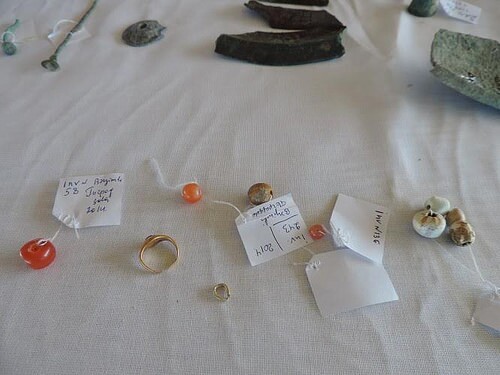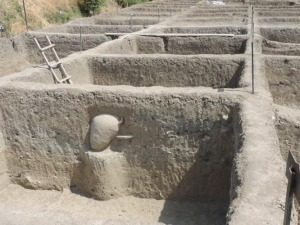
Archaeologists under the auspices of the Agsu Archaeological Expedition of the Institute of Archaeology and Ethnography of the National Academy of Sciences of Azerbaijan have uncovered an early Medieval settlement at the present-day town of Agsu in Azerbaijan.
Beginning in 2014, the excavations have revealed 2000 sq/m representing cultural layers of the third to fourth centuries, AD. Digging to a depth of 2.5-3 meters in separate squares, archaeologists encountered houses and administrative buildings, stone-planked roads, and large ceramic vessels. Other artifacts included copper and silver Roman, Sassanid, and Byzantine coins; bronze and agate seals; dice stones; rare snail-shaped pottery; original ceramic-ware; bone samples; golden jewelry; fragments of gray grinding stones; graters; sling stones; and cutting tools.
The explorations have defined a town that covered 12 hectares, encircled with magnificent Sassanid period fortress walls made of adobe. All edifices studied within the town were constructed with river stone and adobe, although some baked brick was encountered in upper layer materials.
For monument conservation purposes, samples were submitted to the Calabria University of Italy for analyses. Conservation will depend on the results of analyses outcomes, applying nanomaterials.
Explorations in 2015 showed that the ruins were actually those of Mehravan Town, which has been cited in historical sources. This was a town representing the historic Albanian State’s prosperity, mostly a military-administrative center of the Mehranids, who were Girdiman feudals.
_______________________________________
Above and below: Archaeologists at work on the site. Courtesy MIRAS Social Organization in Support of Studying of Cultural Heritage.
_____________________________________________________________
The excavations have revealed 2000 sq/m representing cultural layers of the third to fourth centuries, AD. Courtesy MIRAS Social Organization in Support of Studying of Cultural Heritage.
______________________________________________
Above and below: Pottery and other artifact finds from the excavations. Courtesy MIRAS Social Organization in Support of Studying of Cultural Heritage.
______________________________________________________________
Celebrating and Learning from the Past
Since 2014 an archaeological festival (see www.dayofarchaeology.com) has been held in Azerbaijan under the initiative of the MIRAS (Social Organization in Support of Studying of Cultural Heritage, Azerbaijan). The festival is held every year in the Medieval Agsu Town, with participation of archaeologists, ethnographers, epigraphers, and art historians, as well as volunteers of cultural heritage from the Baku, Agsu, Shamakhi, and Ismayilli regions of Azerbaijan, and also local residents.
The exhibition, “Urban civilization in early Middle Ages-Mehrevan walled town”, was opened in the windows and podiums of the Juma Mosque in the Medieval Agsu Town Archeological Tourism Complex on 29 July, 2016. The exposition reflected the results of archaeological excavations in the Mehravan walled town conducted during the 2013-2015 seasons. PhD archaeologist Fariz Khalilli stated that rich artifacts – such as bronze jewelry items; iron tools; agate seals; coins of Rome, Byzantine and Sassanids; backgammon stones and dice; and bone, stone and glass items, are exhibited. The exhibition will be open at the Juma Mosque for a year.
A one-act play called “Join us”, screened by writer Arzu Soltan and intended for children, was performed by pupils from Agsu. This play encouraged children to be involved in archaeological research and concludes with students’ opportunity to participate in archaeological excavations. The performance was conducted in the main square of Medieval Agsu Town.
At the conference hall of Medievel Agsu Town Archaeological Tourism Complex, epigrapher Habiba Aliyeva and archaeologist Elmira Abbasova lectured about “Pottery to Applied Art: What Do Ornaments Deal With?”. In this workshop, Azerbaijan’s rich history of art, the variety of ornaments and their existence, were discussed with questions answered.
Handicrafts of women from Gagali, Bico and Gashad villages were also exhibited there within the project “The Role of Women in Rural Lifestyle Development”, financed by the Council of State Support to Non-Governmental Organizations under the President of the Republic of Azerbaijan and realized by the MIRAS Social Organization in Support of Studying of Cultural Heritage.
Source: Adapted and edited from a news release of the MIRAS Social Organization in Support of Studying of Cultural Heritage.
___________________________________
The excavations are conducted with support from the MIRAS Social Organization in Support of Studying of Cultural Heritage.
___________________________________

______________________________________________
Travel and learn with Far Horizons.
____________________________________________
This richly illustrated issue includes the following stories: Recent findings shedding new light on the whereabouts of the remains of Philip of Macedon, father of Alexander the Great; how an archaeologist-sculptor is bringing bones of the dead back to life; archaeologists uncovering town life at the dawn of civilization; an exclusive interview with internationally acclaimed archaeologist James M. Adovasio about what makes the Meadowcroft Rockshelter prominent in the ongoing search for the first Americans; what archaeologists are finding at the site of the ancient city of Gath, the home town of the biblical Philistine giant, Goliath; and how scientists are redrawing the picture of human evolution in Europe. Find it on Amazon.com.

